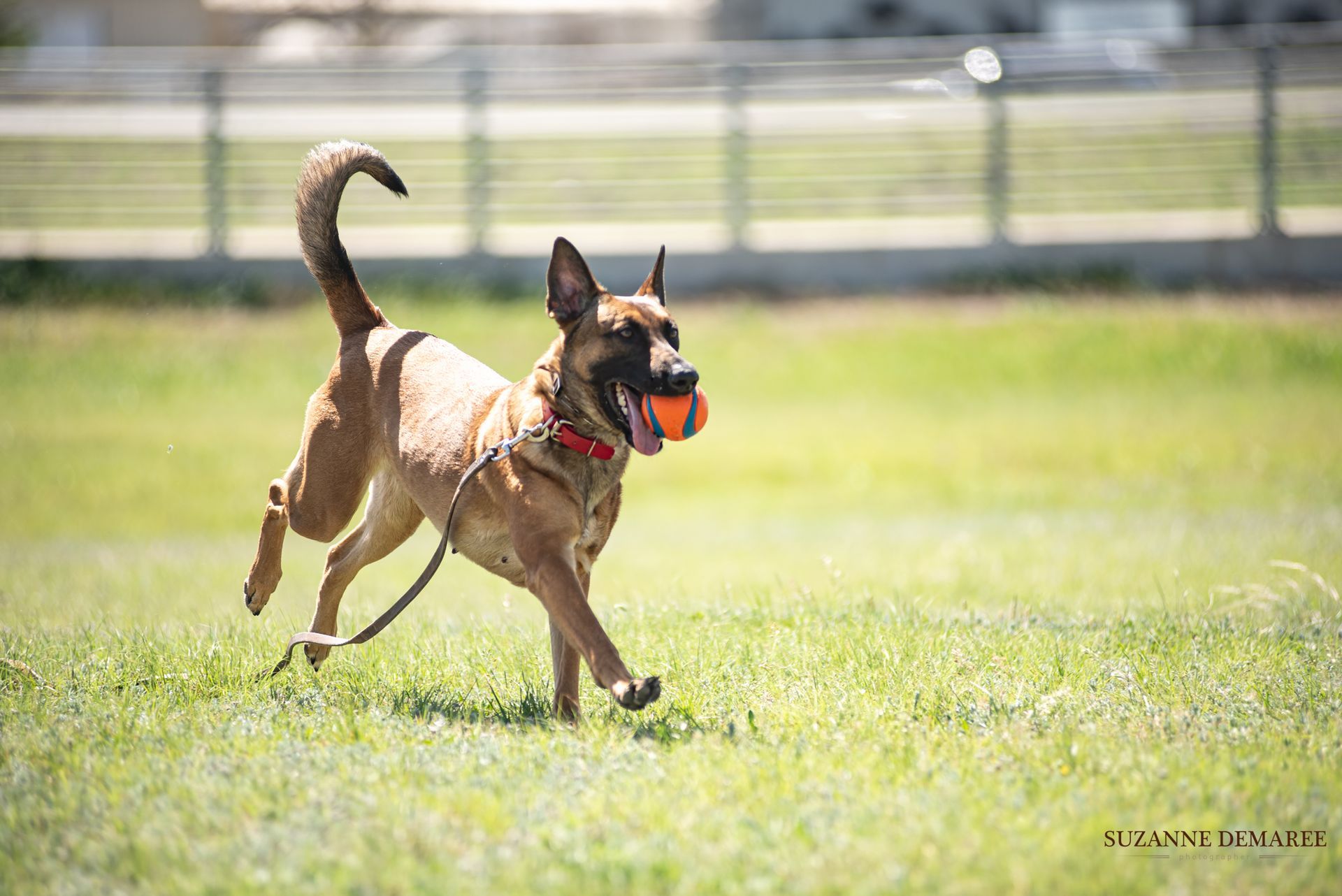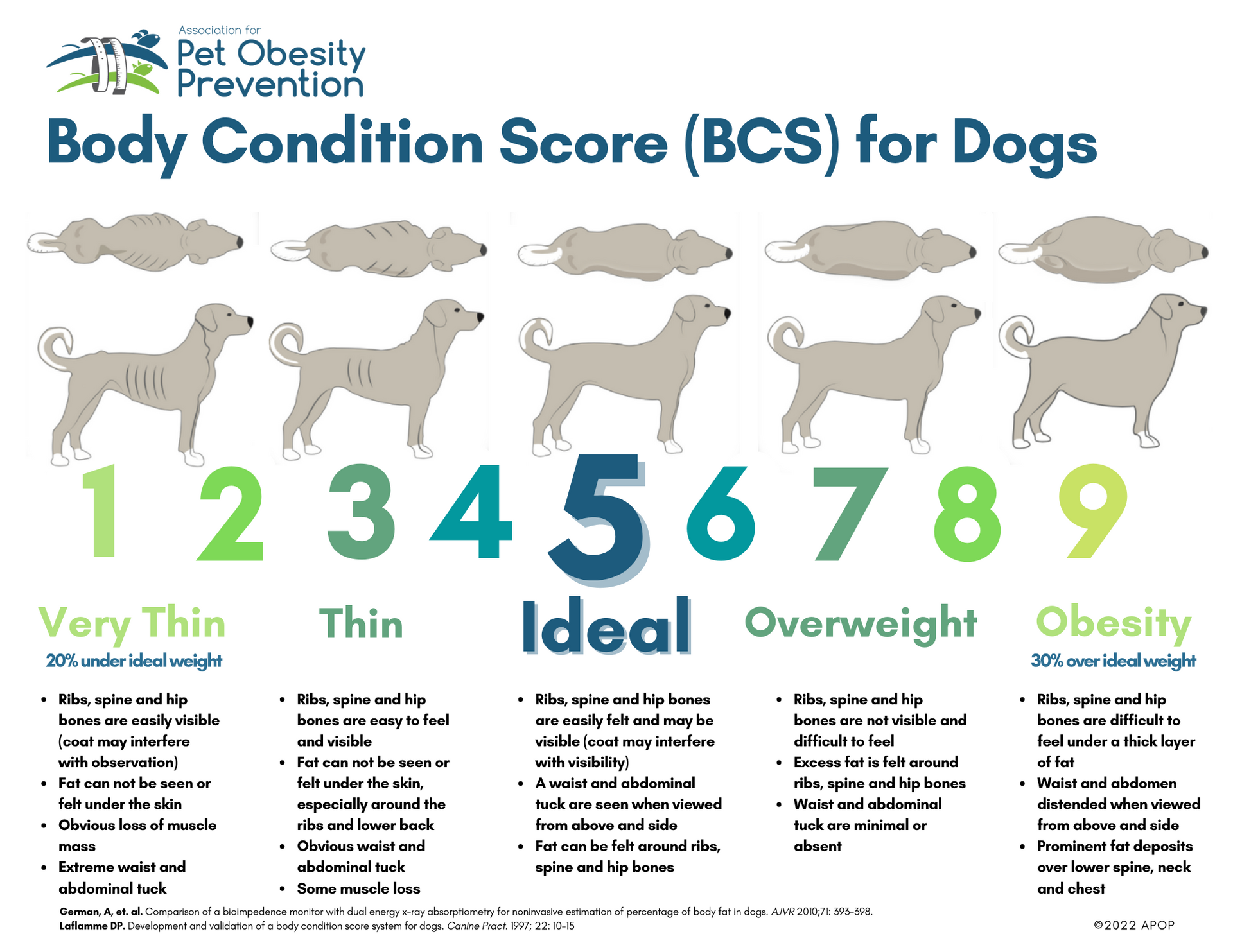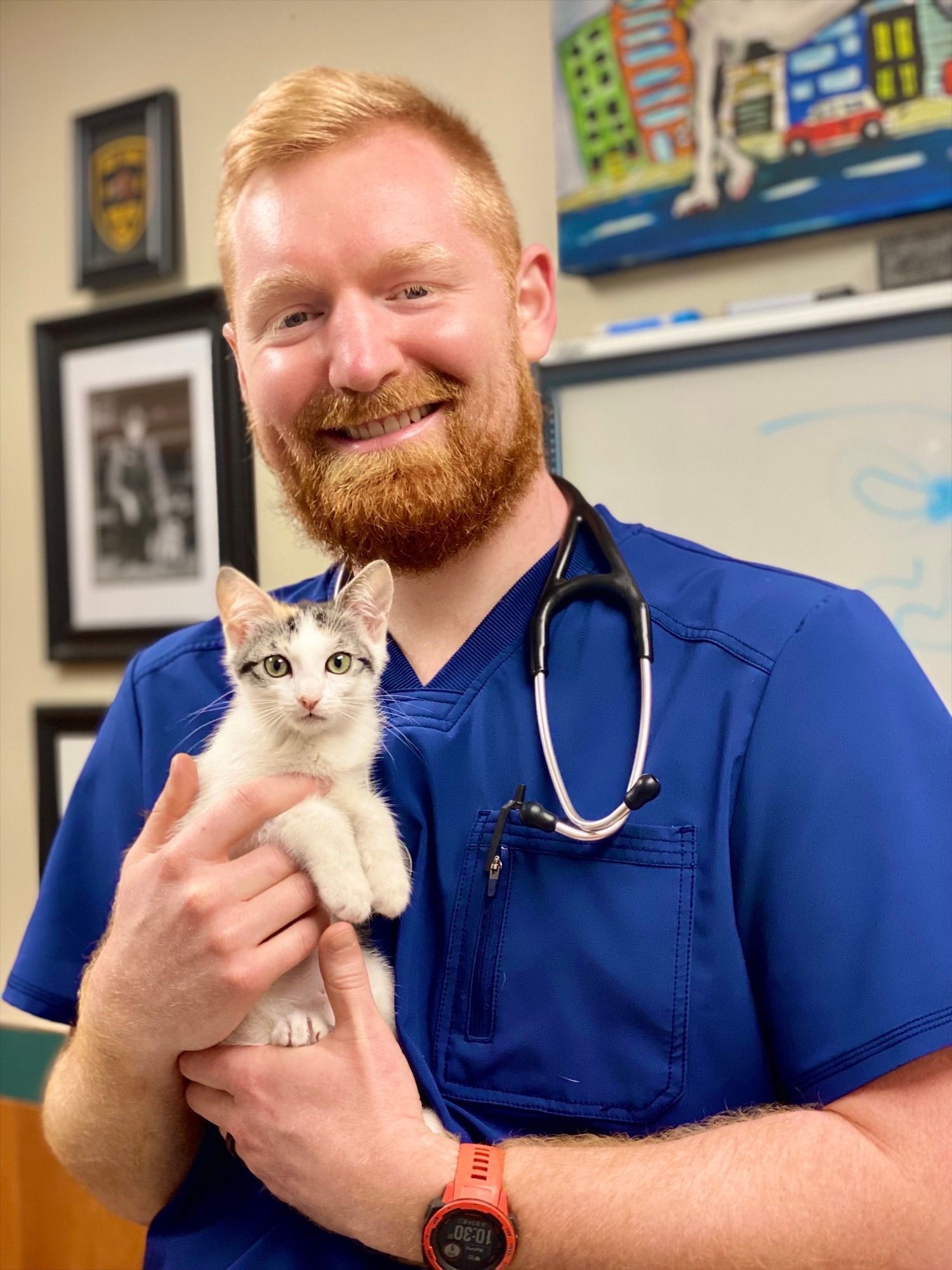Veterinarian's Corner
Dr. Emily Summer Vet Advice
Safe Trails for Happy Tails
Hiking is a wonderful way to keep your dog mentally and physically stimulated—especially for retired working dogs who still enjoy staying active. But while you're out exploring together, it's important to be mindful of the hidden hazards along the way—from contaminated water and parasites to insects, ticks, heat, and unexpected wildlife encounters.
Before you head out on your next hike, here’s what to know about the most common trail-related hazards and how to minimize risk.
Leptospirosis
This bacterial infection is spread through the urine of wildlife such as raccoons, rodents, and skunks. Dogs can become infected by drinking or walking through contaminated water or soil. Leptospirosis can lead to serious liver and kidney damage and is zoonotic, meaning it can spread to humans.
Prevention: A leptospirosis vaccine is available and often recommended for dogs who hike regularly or are exposed to standing water.
Giardia
Giardia is a parasite found in untreated water sources such as puddles, streams, or ponds. Even small amounts of ingested contaminated water can cause gastrointestinal upset, including diarrhea and weight loss.
Prevention: Bring clean water and a collapsible bowl for your dog; discourage drinking from natural water sources.
Tick-Borne Diseases (Lyme, Ehrlichiosis, Anaplasmosis)
Ticks are common in wooded and grassy areas and can transmit a number of serious diseases. Lyme disease, in particular, is prevalent in many parts of the country and can cause lameness, fever, and joint inflammation.
Prevention: Use a consistent tick preventative and check your dog thoroughly after hikes, especially around the ears, neck, between the toes, and under the collar.
Parvovirus and Distemper
These highly contagious viruses are often associated with urban environments but can also survive in soil and organic material in rural or wooded areas. Unvaccinated dogs are especially vulnerable.
Prevention: Make sure your dog’s core vaccines are up to date, including parvovirus and distemper.
Additional Trail Hazards
Foxtails: These barbed grass awns can lodge in your dog’s paws, ears, nose, or eyes and cause painful infections.
Fungal infections: Inhaled spores, especially from disturbed soil, can occasionally lead to respiratory disease.
Insects: Bees, wasps, fire ants, and other biting or stinging insects can cause discomfort or allergic reactions, particularly around the face and paws.
Wildlife encounters: Curious dogs may approach animals like skunks, raccoons, or porcupines, risking injury or exposure to disease. In some regions, venomous snakes such as rattlesnakes may also be encountered on or near trails.
Heat-related injuries: High temperatures, humidity, and vigorous activity can lead to overheating, dehydration, or heat exhaustion. Dogs with thick coats or flat faces may be especially vulnerable. Watch for signs like excessive panting, weakness, or disorientation.
Lakes and still water: Stagnant or warm water can harbor blue-green algae (toxic if ingested), waterborne bacteria, or parasites that cause gastrointestinal upset or skin irritation. Dogs are at higher risk when they drink from or swim in contaminated areas.
Trail Safety Tips
- Keep vaccinations and parasite preventatives current
- Avoid allowing your dog to drink from streams, puddles, or lakes with poor water quality
- Rinse off your dog after swimming to help prevent skin irritation or infection
- Perform a full body check after every hike—look for ticks, burrs, or wounds
- Stay on well-marked trails to reduce exposure to hazards
- Carry a basic canine first aid kit and know the route to the nearest emergency veterinary hospital
- Plan for the weather—hike during cooler parts of the day, bring plenty of water, and monitor closely for signs of heat-related stress or fatigue
Even in retirement, working dogs often retain a strong drive for exploration and adventure. A bit of planning goes a long way in ensuring they stay healthy and safe as they enjoy their next chapter on the trail.
Managing Your Pet's Anxiety or Stress: Tips for a Happier Pet

Just like humans, pets can experience anxiety and stress, which can affect their overall well-being and behavior. Whether it’s due to separation anxiety, loud noises, or changes in their routine, managing your pet's stress is essential for their happiness and health. Here are some tips to help ease your pet’s anxiety:
1. Identify the Cause
Understanding the specific cause of your pet's anxiety is the first step in addressing it. Common triggers for pets include separation anxiety (being left alone), loud noises (thunderstorms, fireworks), car rides, visits to the vet, or changes in their environment (moving, new people or pets). Observe your pet's behavior to identify patterns. For instance, if your dog starts pacing and whining when you're about to leave the house, they may be experiencing separation anxiety. Once you identify the source of stress, you can work on targeted solutions.
2. Create a Safe Space
Pets often find comfort in familiar and quiet spaces. A safe space is a designated area where your pet can retreat when they’re feeling overwhelmed. For dogs, this could be a crate (often called a "den"), which provides a sense of security, or a quiet corner of the house where they feel safe. For cats, a high perch or a cozy hiding spot like under the bed may help them feel more protected. Ensure the space is stocked with their favorite toys, bedding, or even calming music to enhance relaxation. If your pet is fearful of certain sounds, a white noise machine or soft music can drown out external noises that trigger anxiety.
3. Establish a Routine
Pets, especially dogs, thrive on consistency. A regular schedule for feeding, walks, playtime, and even bathroom breaks can give your pet a sense of predictability and control. Anxiety often arises from uncertainty or unexpected changes, so by creating a structured routine, you can help your pet feel more secure. Make sure to keep feeding times and walks consistent, and if possible, try to avoid sudden changes to their environment or schedule, especially during stressful periods like moving or introducing new pets.
4. Provide Mental and Physical Stimulation
Boredom and lack of stimulation can lead to anxiety in pets, particularly high-energy animals. Engaging your pet with interactive toys, puzzle feeders, and mentally stimulating activities can help alleviate stress. For dogs, activities like obedience training, scent games, or learning new tricks can provide mental stimulation, which in turn calms their mind. Physical exercise, such as walks, runs, or playtime, is just as important. Exercise releases endorphins, which help to reduce stress and improve your pet's overall mood. Even a short daily walk or a session of fetch can have significant benefits for their mental health.
5. Use Calming Aids
There are several calming products available that can help reduce your pet’s anxiety. For dogs, anxiety wraps like the ThunderShirt work by applying gentle, constant pressure to calm the nervous system. Pheromone diffusers or sprays, such as Adaptil, mimic calming pheromones that can help soothe pets during stressful events. For cats, Feliway is a popular pheromone-based product that can reduce stress and behavioral problems. Additionally, natural supplements such as CBD oil, calming treats, or herbal remedies (e.g., valerian root or chamomile) can be effective, but it's always a good idea to consult with your vet before using them. These aids are often most effective when used alongside behavioral strategies, such as creating a safe space or providing regular exercise.
6. Consider Professional Help
If your pet’s anxiety is persistent or severe, professional help may be necessary. A veterinarian can help rule out medical conditions that could be contributing to your pet’s stress. In cases where behavior modification techniques alone aren’t enough, your vet may prescribe medications to help manage anxiety. These medications can include selective serotonin reuptake inhibitors (SSRIs), anti-anxiety drugs like alprazolam (Xanax), or other calming prescriptions. Additionally, a certified animal behaviorist can help with behavior modification techniques, such as desensitization and counter-conditioning, to help your pet gradually become less sensitive to their anxiety triggers.
7. Practice Patience and Positive Reinforcement
Managing your pet's anxiety takes time, and it’s important to practice patience throughout the process. Avoid punishing or scolding your pet when they are anxious, as this can worsen the situation and lead to more stress. Instead, use positive reinforcement to reward calm behavior. For example, if your dog remains calm during a thunderstorm, reward them with a treat or praise. If your pet is anxious about being left alone, try short departures, gradually increasing the time you’re away, and rewarding calm behavior when you return. This helps to teach your pet that being alone is not something to fear. Consistent and gentle positive reinforcement can go a long way in helping your pet feel safe and secure.
Final Thoughts
Anxiety is a common issue for many pets, but with the right strategies, you can help your furry friend manage their stress and lead a happier, healthier life. By identifying the cause, providing a secure environment, maintaining a routine, and using calming aids and professional help when necessary, you can significantly improve your pet’s mental well-being. Remember that every pet is different, so it may take some time to find what works best for your individual pet. The key is to be patient, compassionate, and proactive in supporting them through their anxiety.
Vet Advice for Senior Dogs
Dr Tom Hart from Red Bank Veterinary Hospital in New Jersey delivers some advice that will help keep your senior dogs happy and healthy.

What do we expect with a senior dog?
I tell all my clients is that age is not a disease – it’s just a progression of life. Just like humans, ageing is a natural process with changes that we will all go through: We may go grey, our teeth may change and our mobility may decline, our eyes may change. It’s important to understand some of the peculiarities of having a senior dog and that we may have to make certain adjustments to keep up with those changes.
Prevention is always better than cure so in the spirit of keeping on top of any emerging health needs, see your vet twice a year for regular checks – at least. We can check for things that may arise sooner or things that we can discuss that may make things more comfortable as your dog ages.
Over and above any more subtle underlying health issues that your vet will help diagnose and manage, there are several more obvious signs that owners can stay on the lookout for:
- Eye changes: You may notice blue hazing appear on your dog’s eyes. This is called lenticular sclerosis, but I call it the night light disease, as you may just need to leave the light on for your dog to help them see more clearly.
- Appetite: It’s not unusual to see changes in taste or frequency of feeding. This is perfectly normal so try to fall in step with what your dog needs, while continuing to provide a nutritionally balanced, healthy diet.
- Changes in toileting habits: Some of these changes – such as increased urgency or incontinence – are normal part of ageing but they may also be signs of something more serious, so we like to keep a close eye as vets, to make sure we can spot any issues early.
- Sleeping more: Older dogs sleep a lot more and that’s not a problem. Taking naps is a normal thing and they need that to recharge – especially for large dogs. Comfortable, therapeutic, temperapadic bedding is also really important.
- Behavioural changes: Cognitive changes could also be a sign of physical changes or deterioration, so it’s important to keep a close eye on these cues and seek advice from your vet.
Accommodating Bigger Changes
As we get older, our senses often deteriorate and our dogs are no different. We’ve already touched on sight changes that can make life more challenging for your dog and as well as the milky lenses that can cause issues in dim light, vision loss can make general navigation difficult. Stairs can be a tough ask, when this happens, so it’s good to think through some alternative situations to help your dog avoid any unnecessary challenges.
Hearing loss is common too and that can impact responses. Simple hand signals can be easily taught and will help you to communicate with your dog, without startling them. Your dog’s sense of taste can be impacted too, so making it more palatable or changing foods can help to maintain appetites.
Aches and pains are common as we age and arthritis is a common ailment for older dogs. They may not be able to jump up or down as easily and this can lead to anxieties and potentially, some aggression too. There are some great medications or treatment plans that can really help dogs with aches and pains. Alternative therapies can also complement a medicinal regimen, with a host of great options on offer, such as water therapy, acupuncture and cold laser therapy.
When I have clients come in who are preparing to retire a senior dog from active duty (I see a lot of military, police and TSA clients), I’ll talk a lot about mobility for large breed dogs so that’s a big one. Moving their bedding closer to the ground, having traction on the stairs, matting on hard wood floors are all great ways to help your dog out. Having harnesses for bigger dogs are great for when you need to help them up a little.
Happy and Healthy
The adaptions a dog owner can make to ensure a healthy, happy senior dog enjoys his or her twilight years are simple but can be very effective, and your vet is an excellent sounding bound to run through ideas and hacks. We often talk about nutrition with owners, as it can be a delicate balance to make sure things are running smoothly for our older dogs. Not every dog needs to switch to a senior type of food, but quality is key – they need well-balanced foods just as much as they did when they were puppies. Protein is so important too, as older dogs lose muscle mass quickly, so a high protein diet is vital to aid in repair and regeneration.
It’s easy to think that older dogs don’t need to be exercised, but this is a key part of their enrichment. It might not be quite the exercise that they used to do as young dogs, but making sure your seniors have a good walk should never be neglected: Whether you are able to walk around the block or even to the front door and back – its importance cannot be understated.
Our senior dogs might not be doing bingo or crossword puzzles, but we should indulge in the things that they love in life to keep them mentally stimulated. Food puzzles are great, or letting them have a good old sniff around town, which is not only super important for them to get to know their surroundings, but it really is also a feast for their minds too. If your dog enjoys a car ride, this is also a great way to interest and stimulate them when they might not be as nimble as they once were. Making life interesting so they can remain themselves and do what they love will ensure that you continue to see their personality shining through.
Having a routine for an older dog is great as you can pick up on any small changes that may occur. The routine may change as they slow down but that’s ok. They will also feel that sense of assurance that all is well in the world, when they know what to expect with key events such as mealtimes, walks and bedtime.
Enjoying Our Senior Dogs
I had to say a painful goodbye to my Great Dane, Bella, earlier this year. Despite all the literature and expectations as to her life span, she lived to be the ripe old age of 13, and I was grateful for every day I got to spend with her. I lived through a lot of the changes that have been discussed here, as Bella adjusted to life as a senior citizen and many owners will feel the natural turning of the seasons as they watch their dogs slow down with old age.
There is constant discussion in the veterinary profession around what else we can do for our elderly dogs and there are a lot of cutting-edge technologies to help to increase life expectancy. Of course, we want them to live a long and happy life, where their quality life is just right.
Ultimately, the most important medicine we can give to our dogs, is love. I know that Bella certainly benefitted from lots of that! The amount of unconditional love our dogs give us is far more than we can give them, but we can certainly try.
Nutritional and Therapeutic Supplements: Benefits and Usage
Nutritional supplements, sometimes referred to as nutraceuticals, have had increasing popularity over the years, but especially since 2020. Market projections only show this continuing to grow over the next decade. Most commercial diets have all the dietary requirements for vitamins and minerals, but there are instances where supplements can be beneficial for your pet. We will discuss a few of the most common supplements and when to consider using them.

Joint Supplements
Joint supplements are a great addition to the diet of any large breed or active dog. Other animals that would benefit are ones that have had a musculoskeletal injury with an increased risk for osteoarthritis development, those with hip dysplasia, and those with loose joints. The most common ingredients that are included are glucosamine, chondroitin sulfate, MSM, ASU, and hyaluronic acid. These ingredients help to promote joint health and mobility, as well as promote joint lubrication and comfort.
Joint supplements do not prevent changes such as arthritis but they do help to slow the progression of development of chronic changes. In some cases, they can decrease the need and/or dosage of pain medications such as non-steroidal anti-inflammatories. The important thing to know about these supplements is that they must be given daily for them to be truly effective. Additionally, these usually require a loading dose where a larger amount is given for a short period of time to reach peak concentrations in the body before being reduced to a maintenance dose.
Fatty Acids
Omega-3 fatty acids are found primarily in fish oil supplements as docosahexaenoic acid (DHA) and eicosapentaenoic acid (EPA). They have incredible benefits throughout the body, used for arthritis management, brain and central nervous system development, heart and kidney health, immune system support, skin health, and cognitive function in older dogs. Coldwater fish such as salmon or trout are great sources for DHA and EPA.
Omega-6 fatty acid is primarily found in safflower, corn, sunflower, and canola oils as linoleic acid (LA). LA supports the skin barrier by boosting ceramide formation, found in the outermost layer of skin. This helps in decreasing dander, boosts hair growth, and improves coat quality. While oils such as flaxseed contain both omega-3 and omega-6 fatty acids it is not a good source of active DHA and EPA, so a fish oil source should also be given.
Probiotics
Gut health plays an important role in immune system health so methods to support the beneficial bacteria living in your pet’s intestinal tract are now more readily available. Probiotics not only help to break down food, but they also boost and support the immune system. These are generally not needed routinely but can be helpful in cases of gastrointestinal upset (such as vomiting and diarrhea), allergies, stress, or with animals exhibiting anxious behaviors. The underlying reason for considering a probiotic will dictate how long the pet should receive it, which could range from weeks to months. Veterinary specific products are recommended as many of the human probiotics contain ingredients that are unsafe for our pets.
Nutritional supplements can have a positive effect on the development and long-term health of your pet. While generally safe, it is recommended that you discuss your specific pet’s needs with your veterinarian prior to starting any supplementation.

Become Your Dog’s Personal Trainer
Food is a universal love language and when our dogs turn on the dough-eyes and play us while we’re eating something delicious, it can be hard to say no. It is scarily easy to overfeed your dog and with obesity in K-9s on the rise across the country, US Army Major Emily Bingham shares her tips for how we can keep our dogs in the best possible shape.

Beware the doggy dough-eyes
Pet obesity is not a new problem, but its prevalence has increased in recent years. According to a 2022 study, the Association for Pet Obesity Prevention estimated that 59% of dogs and 61% of cats in the United States were overweight or obese. Determining your pet’s healthy body weight can be difficult; there are weight standards published by the American Kennel Club for purebred dogs, but none exist for the millions of mixed-breed dogs. Add in variations in body stature, age, and activity level, and the ability to assess your pet’s appropriate weight becomes even more difficult. However, routine monitoring and adjustment of their diet and/or exercise level is critical in keeping them healthy.
Similar to body mass index used for people, veterinarians use either a 5-point or a 9-point body condition score (BCS) to attempt to quantify your pet’s physique and determine if they are in a healthy body condition range. The designated numbers range from emaciated (score of 1 on either scale) to obese/severely obese (score of 5 or 9 on either a 5-point or 9-point scale). The BCS measurement is inherently subjective, meaning that it can vary between the individuals performing the measurement. In attempts to make it more objective and reduce variation a standardized approach including visualization and palpation was developed.
Starting with visualization, your pet should be observed from above and from the side. Ideally, your pet will have an hourglass figure as well as a tummy tuck, or a slanting upwards of their abdomen towards their hind legs. Additionally, you should not be able to see individual bones of the spine, nor should you see pelvic bones. Palpation involves a hands-on approach where the grader will run their hands along your pet’s ribcage to feel how much muscle and fat coverage is present over the ribs. In this technique, ribs should be felt easily without applying excessive pressure, but they are usually not visualized. Another way to understand ideal palpation is to compare the feeling of your pet’s ribcage to the feeling of your knuckles: too thin is feeling your knuckles with your hand in a fist, too fat is feeling your knuckles on the palm side of your hand, and ideal is feeling your knuckles with your hand in a flat position. The spine and pelvic bones should not be easily felt in an ideal body condition.
Once a BCS has been established, an ideal weight range can be determined and daily caloric need can be calculated. It should be noted that ideal weight ranges are not fixed for the life of the pet and will need adjustments based on age and activity level. The total volume of food to be fed is then established from the calculated daily caloric need. If a reduction of food is needed, the difference between the previous and new amounts can be made up with vegetables. For example, if it is determined that your pet requires 1 cup of food a day but they had been receiving 1.5 cups a day, a half cup of pet safe vegetables such as green beans can be added to the diet. This helps reduce the total calories consumed without reducing the volume and can make the transition easier.

A handy visual to explain the body condition scoring system
Increasing activity level is important in a weight reduction program. The type, length, and frequency of exercise should be based on your pet’s breed, age, and current physical condition. For some pets this may be three 5-minute periods of fetch or this may be a 30-minute brisk walk. Other techniques to increase daily movement include moving the food bowl upstairs or downstairs, feeding your pet in a treat ball or puzzle feeder, and using a variety of toys such as laser pointers and balls. It is especially important to minimize table scraps and treats because even a robust exercise program can’t make up for bad nutrition.
Depending on your dog’s size and current condition, it should be expected that they lose one to five pounds a month. Your veterinarian can help determine if your pet’s ideal weight range should be adjusted, as well as establish an appropriate diet, but the most important component for a weight loss program is having a dedicated and committed family supporting the process. Together, you and your veterinarian can help your pet achieve a healthy body condition safely and successfully.
Red Bank's Dr. Tom Hart Provides His Expert Advise

Dr Tom Hart gives his advice on how your pets can have a parasite free summer
Our temperate climate has allowed both native and non-native species of fleas and ticks (known scientifically as ectoparasites) to make comfortable homes here in the US.
The proliferation of parasites means that we owners have to stay vigilant and ready to take action, as these nasties are highly preventable. I treat a large number of police and other service dogs and even these animals, who are in top shape, aren’t immune to the scourge of parasites. Of course, if our pets contract a parasite, it isn’t just them who suffers. They share the love with us too, which is why we want to take extra care to ensure these infestations are prevented.
With terrifying news stories of celebrities like Avril Lavigne contracting the fierce and debilitating tick-borne Lyme Disease, people are right to be concerned. Historically most commonly found in the North East of the country, the disease is spread by the deer tick and its prevalence is spreading further south and east as changes to our climate impact the tick species.
As with so many diseases, public fear drives people to take action and this really helps us veterinarians to extol the virtues of preventive care, which not only benefits the pet, but the owner too. Lyme is a widely misunderstood disease that is known to cause autoimmune conditions, joint and kidney complaints.
The difficulty for us veterinarians when it comes to Lyme Disease, is that the symptoms are often non-descript, which can make it that much more frustrating to diagnose and treat. Much like COVID-19, we still have much to learn about its behaviors' and outcomes.
It isn’t just the deer tick that can cause problems for us and our pets. A bite from an Asian long horn tick has been known to cause specific and violent intolerance to meat – both in pets and in humans. Sadly, illnesses caused by tick-born infections are on the rise across the US, including heartworm disease, anaplasmosis and ehrlichia.
One proven way to test whether an animal has been exposed to tick-borne disease is a 4Dx Snap Test, which tests for antibodies and can help guide the treatments needed.
A C6 Quantitative Test is also available to measure the number of antibodies, which shows how long the disease has been present and how severe the animal’s reaction has been to it.
Fleas are widely known as pest one-oh-one for pet owners. The mere mention of these dirty little critters instils fear and often, instant psychosomatic itching. Fleas need an animal host in order to enter our homes and cause us problems, so if we treat our pets, we are cutting them off at the source.
Fleas irritate the skin by biting and sucking small droplets of blood from their helpless host and once they have settled aboard your dog or cat, can migrate to us humans too, setting up home in our carpets, bedding and clothing. Fleas love warmer weather but can survive quite happily all year long, so prevention is a regular job.
The great thing about these nasty problems is that they can be very easily prevented. Don’t feel overwhelmed by the sheer amount of options out there. Speak to your veterinarian to discuss which treatment is best for your pet and your lifestyle. Convenience is king so make sure you pick a solution that works best for you. For example, some treatments last three months, which means it is one less thing for pet owners to worry about each month.
Tablets, topical treatments and collars are all safe, effective therapies and nowadays there is a treatment to suit all budgets.
As with all preventive treatments, there is a good deal of fear, panic and confusion surrounding their impacts and effectiveness and whether they are safe for pets and people. As a professional veterinarian with over nine years in clinical practice, I can say with certainty that negative side effects are rare and minimal and that the pros definitely outweigh the cons. My 13.5 year-old Great Dane, Bella, has been taking these preventive medications her whole life and she is still thriving.
Dr Google has a lot to answer for when it comes to navigating options for preventive health. Sadly, I have seen cases where owners have taken the advice of unqualified individuals online, using tea tree oil as a method to treating a flea infestation and not realising that it is incredibly toxic to pets.
In this age of misinformation, please rely on the wise words of your vet to guide you and know that the right kind of prevention in every case, is better than cure.
Heat Stress Injury in Dogs: Signs, First Aid, and Prevention

Many of us are more than ready to be done with the cold, dark days of winter, but as the mercury rises, our dogs can fall foul to heat stress that can cause an array of nasty side effects. US Army veterinarian Dr Emily Bingham has kindly provided us with some guidance on how to prepare your dogs for the warmer weather, to make sure they remain healthy and happy during the summer months.
After a particularly cold winter, temperatures in many areas are starting to rise. The warmer weather brings more opportunities to enjoy being outside and active, but it also brings an increased risk of heat injury to our pet population. To help you prepare for the change in seasons we’ll discuss how to recognize the symptoms of heat stress, immediate first aid actions, and prevention methods.
Heat stress is a term that describes when a dog is exposed to excessive heat and their body temperature rises above the normal range of 99.5-102.5 degrees Fahrenheit. Since they have few sweat glands, their primary option to cool off is through panting. In some cases, this is not enough to lower their temperature and they can develop heat stroke, a life-threatening condition that can lead to severe consequences.
Heat stress symptoms can occur even in the absence of traditionally “hot” temperatures. Pets who exercise excessively in warm or humid weather, have a pre-existing condition (particularly breathing or heart problems), are overweight, old, or very young, have thick hair coats, or are breeds who inherently have breathing difficulties such as bulldogs, boxers, or pugs are also susceptible to heat stress injuries. Early symptoms of heat injury include excessive panting, restlessness, shade seeking, and increased heart rate. Advanced symptoms include disorientation, collapse, seizures, vomiting, and diarrhea (with or without blood).
If you are concerned that your pet is experiencing a heat stress injury you should immediately take steps to cool them down. This includes placing them in the shade or in an air-conditioned environment, preferably with a fan directed on them. Pouring or hosing them with cool water or placing a wet towel on them will help aid in dissipating heat. Do not use ice-cold water or ice packs as this can reduce blood flow to the skin and impair their ability to cool down. These interventions can cause a rebound hypothermia, so it is important to monitor their temperature frequently and stop all active cooling methods when their temperature reaches 103 degrees Fahrenheit. Once you have initiated therapy, seek veterinary care for your pet. Serious internal damage can develop including bleeding disorders, kidney injury, and sepsis, so even if they improve they should still receive a thorough physical examination.
Despite the risks of warmer weather, there are ways to safely enjoy it with your pet. Ensure that your pet always has access to a shaded area and that they have drinking water available when outside. Wading pools are a great way for your pet to cool themselves off if needed. Restricting exercise on warm days or limiting the hours of exercise to early morning and later evening will minimize their exposure to the hottest part of the day. Additionally, checking the temperature of the pavement before walking your pet will ensure that they do not inadvertently burn their paws. If your dog requires grooming, keeping them regularly groomed will help them get through the hottest months. On extremely hot days, keep your pets indoors except for short outdoor bathroom breaks.
Recognizing the signs and symptoms of heat stress injuries, knowing how and when to apply first aid, and mitigating risks while reducing exposures will ensure that you and your pet enjoy a safe summer.
Pet Euthanasia: When to Say Goodbye
Pets bring so much joy to our lives, providing comfort, levity, and companionship making it hard to imagine our lives without them. Unfortunately, at some point, a difficult decision will need to be made to say goodbye. As a veterinarian trained in emergency medicine, euthanasia or “putting to sleep” is something that US Army Veterinarian, Emily Bingham, has had frequent experience with. In this article, Emily will consider frequently asked questions from owners regarding how to know when it’s time to say goodbye, how the procedure is performed, and what to do after it’s done.
When to Say Goodbye?
It’s very difficult to make decisions in the moment, so considering your wishes for your pet before that day comes can help ease the stress of the moment.
For most pet owners the most important thing affecting their decision is their pet’s quality of life. Pets, especially cats, can be very good at hiding chronic illnesses and subtle changes are often missed due to their gradual nature. Each pet is different and they each enjoy different things, but behaviors that may be indicative of a decline is anorexia, hiding, losing weight, excessive panting or pacing indicating anxiety or pain, or an inability to move for routine behaviors such as going to the food bowl or going outside. To help recognize these deteriorations there are a few different ways to assess them objectively.
One way is to make a list of all the things that your pet loves to do and then keep that on the fridge or other area in the home where it will be seen often. Examples include appetite or eating, walks, seeking attention, and playing with a favorite toy. As time goes on and more of those things are crossed off the list due to mobility issues, nutritional issues, or other impairments it may aid in recognition of a declining quality of life.
Another option is to simply hang a calendar where it will be seen frequently, and on each day indicate whether it was a “good” day or a “bad” day with a corresponding smiley face or sad face. Seeing a run of sad faces can give an idea of the length of deterioration as well as allow for an objective assessment of your pet’s wellbeing.
There are also online resources that have interactive questionnaires, calendar printout examples, and variations on quality of life assessments that can be helpful in aiding with an educated and informed decision.
Lap of Love – a company that specializes in veterinary hospice care and in-home euthanasia options, is an excellent online resource. Additionally, your veterinarian can help answer questions and discuss your pet’s individual health.
How is the Procedure Performed?
In the majority of cases, your pet will receive an intravenous catheter to ensure that when the medications are given that they will be administered painlessly and effectively. Often a sedative is given initially; this will relax your pet and allow them to dissociate from any discomfort that they are feeling. Once these effects are seen, an injection of a pink or blue solution will be given. This is an overdose of a medication that will stop heart and brain functions and allows for a peaceful passing. The effects of this medication are very fast, often only taking 30 seconds or less. Twitching and deep or final breaths may be seen and they may lose control of their bowels. Additionally, they usually do not fully close their eyes after they pass. All of these are normal reflexes involved with death.
Next Steps
There are usually two options in regards to the aftercare of your pet. The first option is to bury your pet at home. In some states this is illegal due to the medications used in euthanasia so it is best to check your local, county, or state ordinances ahead of time. The second option is cremation, either communal cremation or individual cremation. With communal cremation your pet will be cremated with other pets and you will not get their ashes returned to you. With individual cremation your pet’s ashes are returned. In most cases veterinary clinics will make paw prints or clay paws, but some crematoriums also have options for memorabilia.
In an ideal world our pets would live forever, and in lieu of that the best option would be a peaceful passing on their own. However, in most cases this is not the reality we are faced with. Euthanasia is derived from Greek and means “good death”. It is always a difficult decision and not one that is taken lightly, but in most cases, it can be the kindest final gift you give your pet.

Pet Health Tips From US Army Veterinarian, Dr Emily Bingham
US War Dogs has called on the help of serving US Army Veterinarian, Dr. Emily Bingham, to provide us with some general health tips to keep our four-legged friends happy and healthy.
Dr. Emily received her Doctor of Veterinary Medicine in 2011 from Kansas State University and upon degree completion she commissioned as a Veterinary Corps Officer in the United States Army. During her time in the military, she has provided veterinary medical care to the United States Secret Service, Transportation Security Administration, and the Pentagon Force Protection Agency, as well as served as the lead veterinarian for Marine Corps Forces, Special Operations Command. Dr. Bingham completed specialty training in veterinary emergency medicine and critical care at the University of Florida in 2021 and currently serves as the Veterinary Clinical Medicine Instructor at Fort Campbell, KY
Americans love their pets and often treat them as invaluable members of the family. They bring their owners joy and happiness, as well as increase opportunities for exercise, socialization, and companionship. Because of the important role they play in our lives, it is important to keep them healthy and safe. Here are five tips that can help do just that.
- Annual veterinary visits
Yearly veterinary examinations for pets goes far beyond just routine vaccinations and preventive medicine prescription refills. Animals are very good at hiding abnormalities, and veterinarians are trained to uncover subtleties through thorough physical examinations of the pet coupled with discussions with their owners. Early diagnosis is also likely to be less costly by allowing for treatment before an illness has become more serious or advanced.
- Vaccinate and use monthly prevention
For optimal health, regular vaccinations as well as monthly preventatives are recommended. The types and frequencies of vaccinations depend on a pets age and lifestyle and discussing these with your veterinarian will ensure they are receiving the appropriate care. Additionally, using a monthly flea and tick preventative, as well as a heartworm and intestinal parasite preventative will not only keep your pet healthy, but can prevent the unintended spread of parasites to their owners.
- Spay or neuter your pet
There are multiple health benefits to spaying and neutering your pets. Most importantly, it reduces and, in some cases, prevents certain cancers and life-threatening infections. Surgical alteration also lowers the tendency for roaming, which is the most common reason for automobile accidents, traumatic injuries, exposure to poisons, or even attacks from other animals.
- Microchip your pet
The best reason to have your pet microchipped is that it improves the chance that they will be found if they are lost or stolen. A study of more than 7,700 stray animals found that dogs without microchips were reunited with their owners 21.9% of the time, whereas microchipped dogs were returned 52.2% of the time. Once they are microchipped it is imperative that any information is updated as soon as it changes, including the owner’s contact phone number and address.
- Keep your pet at a healthy weight
Obesity is the number one nutritional disease seen in both dogs and cats, and studies have shown that obesity shortens their lifespan by as much as two years. Being overweight has secondary effects on the body, such as joint disease, heart disease, and diabetes. Feeding your pet an appropriate amount of a high-quality diet will improve their hair coat and skin, strengthen their immune system, and help keep their gut, joints, and muscles healthy.
Following these tips as well as communication with your veterinarian will help provide a long and healthy life for your pet

K-9 Spring Safety Tips From Major Erin Hennessey, Army Veterinary Corps
The Veterinary Corps conducts and oversees all Department of Defense veterinary service activities providing veterinary services to the Army, Navy, Marine Corps and Air Force in more than 90 countries. Erin Hennessey has spent most of her career serving with the Marines at Twentynine Palms and Camp Pendleton, providing veterinary support to military working dogs, IED defeat dogs, and multi-purpose canines. Erin is board certified in Veterinary Preventive Medicine and currently completing a residency in Veterinary Radiology at Kansas State University. Outside of work, she enjoys cooking, baking, weightlifting, and trying to keep up with her 4-year-old. Enjoy Erin’s tips on keeping your K-9 safe and happy this spring.
Spring means warming temperatures and fun festivities, many of which can be enjoyed with your canine friends. Unfortunately, some of the best parts about spring can result in veterinary visits. Below are some tips to keep your dogs happy and healthy through the spring holidays and into warmer weather.
No Easter is complete without sweet treats and egg hunts, and many dogs feel the same way! Dogs may choose to join their humans in an egg hunt or sneak a treat from an Easter basket. However, there are a few candy-related concerns to be aware of in dogs.
Chocs Away
Of particular concern for dogs are candy (and other products) containing xylitol. This ingredient is becoming increasingly popular in sugar free candies, mints, and gums and even liquid medicines. It is EXTREMELY toxic to dogs. Ingestion of a xylitol-containing product is NOT a wait and see situation. Any suspicion of xylitol ingestion requires immediate emergent care for induction of vomiting and decontamination (activated charcoal administration for you prior handlers out there).
Intravenous fluids and monitoring bloodwork will likely follow with additional care as indicated by the dog’s status. Xylitol causes severe hypoglycemia (low blood sugar) and liver injury, and dogs can become critically ill very fast. Unfortunately, xylitol ingestion is not always known before a dog becomes sick. Affected dogs may develop weakness, ataxia (wobbly), vomiting, seizures, and jaundice (yellow tint to skin). Avoiding xylitol-containing products around your dogs is the safest route, so remember to check those ingredient labels!
No Easter basket is complete without a chocolate treat (or several!) and canine chocolate toxicity is a well-known concern. Chocolate contains caffeine and theobromine, which dogs cannot handle the same way humans do. Dogs with chocolate toxicity may have vomiting, diarrhea, high heart rate, irregular heart rhythm, and even seizures at very high doses. Luckily most sweet treats are of the milk chocolate variety which is less toxic to dogs. More concentrated (usually more bitter) products such as dark chocolate, cocoa powders, and even cocoa bean mulch are more dangerous.
Fortunately, there are a number of chocolate toxicity calculators available on the internet to help determine the level of risk should your pooch steal a chocolate Easter bunny. Low levels of ingestion may cause some stomach upset, but higher levels of ingestion should prompt a visit to your veterinarian.
Not-So Sunny Delight
Aside from holiday fun, spring means sunshine and warmer temperatures. It’s tempting to leave your dog in the car for a quick run in to a store as you’re out and about. On a 70°F day, the interior of a car can reach 100°F in about 20 minutes. Even on a cloudy day, cracking the windows doesn’t really help. Add in a panting dog (or dogs) and you have a recipe for heat injury. Best to leave the dogs at home when running errands and go pick them up later for that trip to the park.
For more vehicle safety tips, click here.
Vet Visits
This conversation would not be complete without talking about the current state of veterinary medicine. In short, COVID (and other factors) have drastically impacted the profession, resulting in a major shortage in capacity of care relative to the number of pets needing it. This can result in long wait times (weeks to months) to get into primary care veterinarians for routine concerns, and prolonged times for urgent but non-emergency appointments (such as ear infections). Emergency hospitals are also working beyond capacity with multi-hour waits, and many are turning away patients who are not true emergencies. Plan ahead for routine care such as vaccinations, heartworm testing, and prescription refills. Have a canine first aid kit at home to take care of minor injuries (handlers, I am looking at you!) as well as other care supplies such as ear cleaner.
And don’t forget to be nice to your vet staff!

